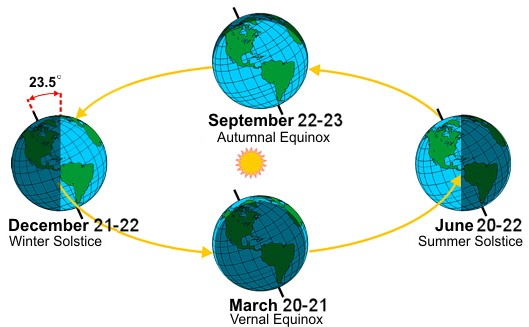JUNE 21 SUMMER SOLSTICE IN NORTHERN HEMISPHERE

June 20-21 is a very important day for our planet and its relationship with the sun. June is one of two solstices, days when the rays of the sun directly strike one of the two tropical latitude lines. It marks the beginning of summer solstice in the northern hemisphere. It simultaneously heralds the beginning of winter in the southern hemisphere.
LONGEST DAY
A solstice occurs when the sun’s zenith is at its furthest point from the equator. During the June solstice it reaches its northernmost point and the Earth’s North Pole tilts directly towards the sun, at about 23.5 degrees. We also call it the northern solstice because the sun is directly over the Tropic of Cancer in the northern hemisphere when it occurs.
The June solstice day has the longest hours of daylight for those living north of the equator. Those to the north of the Arctic Circle are able to see the “midnight sun”, where the sun remains visible throughout the night.
Those to the south of the Antarctic Circle will not see the sun during this time of the year. The length of day temperature does not vary as much.
On June 21, there are 24 hours of daylight north of the Arctic Circle (66.5° north of the equator).24 hours of darkness south of the Antarctic Circle (66.5° south of the equator).In the southern hemisphere, the June solstice is the shortest day of the year.
It is when the sun has reached its furthest point from the equator and marks the first day of winter.
LEARNING FROM HOME
Axis is an imaginary line going right through the planet between the north and south poles. The axis is tilted somewhat off the plane of the earth’s revolution around the sun. The tilt of the axis is 23.5 degrees; thanks to this tilt, we enjoy the four seasons. For several months, one half of the earth receives more direct rays of the sun than the other half.
The equator is located at zero degrees latitude. The equator runs through Indonesia, Ecuador, northern Brazil, the Democratic Republic of the Congo, and Kenya, among other countries. It is 24,901.55 miles (40,075.16 kilometers) long. On the equator, the sun is directly overhead at noon on the two equinoxes – near March and September 21. The equator divides the planet into the Northern and Southern Hemispheres. On the equator, the length of day and night are equal every day of the year – day is always twelve hours long and night is always twelve hours long.
The Tropic of Cancer and Capricorn each lie at 23.5 degrees latitude. The Tropic of Cancer is located at 23.5° North of the equator and runs through Mexico, the Bahamas, Egypt, Saudi Arabia, India, and southern China.
The Tropic of Capricorn lies at 23.5° South of the equator and runs through Australia, Chile, southern Brazil (Brazil is the only country that passes through both the equator and a tropic), and northern South Africa.
Longitude measures the angular distance of any point on Earth east or west of a point on Earth’s surface
When looking at a map, latitude lines run horizontally across the map. These lines are also known as parallels and are equidistant from each other. Each degree of latitude is approximately 69 miles (111 km) apart;. Degrees are numbered from 0° to 90° north and south. Zero is the equator. 90° north is the North Pole and 90° south is the South Pole.







0 Comments